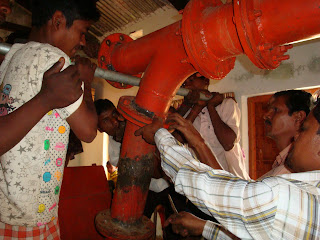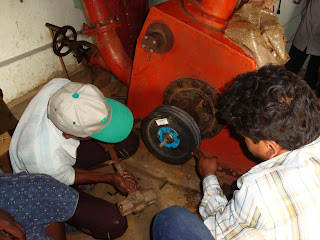Hola! Halo! Ibowen! Namaste!
In the wake of an interesting conference call yesterday, between academicians, policy designers, and practitioners, the following thoughts/conclusions came spurring this morning. I am sharing them to get input from you:
1. Money is directed by the intellectual community. For example, money for large scale implementation is directed by policy makers and government. And money for research and development, which should ideally include innovation (for practical issues!), is dictated by academics.
2. Yet, in all cases, the interface between the funds and the actual work that will consume those funds falls on the plates of practitioners.
3. Policy makers and academicians work within (intentional or unintentional) self-serving, self-strengthening associations. For example, in the policy maker world: what is the policy based on -- actual results or ideals/abstracts, where the only tangible data point becomes the image of the ruling government. In the academic world: who besides academicians, reads all the theses, dissertations, and journals? Besides academicians, who writes these papers? Who gets paid for them? Who gets degrees for them? How many of those degree-ed products of academia go into practice? How many of them go back into a closed loop, research setting? Because policy makers and academicians work within self-strengthening, closed loops, they attract human resource, often young energy, that eventually (and unfortunately) roots itself within the same closed loop that has little sense of the outside realities.
4. Yet, in the practitioners world, there are hardly any networks or associations. This maybe because practitioners cannot work within self-serving, closed loops (even if they wanted to). The ends of their loop can never meet because their reality cannot be boxed or looped into an abstract world of words on paper. The interface of their work includes the reality of living communities, human natures at their extremes, the elements (e.g. malaria, maoists, mines), and unplanned budgets that have no choice but to make the work happen. Therefore, the structured closed-loop, self-serving associations that the policy makers and academicians thrive on may not be adequate for practitioners. Maybe, practitioners need organic and flexible associations?
Surely, practitioners need space to be passionate, to be quirky/nerdy, and to be activists that give voice to the masses. Yet, to survive financially, practitioners are forced into the same funding structures (which as I mentioned earlier are dictated by non-practicing worlds), often creating white elephant NGOs (and unintentionally aloof executive directors that once had the freedom to give all of himself to the field, rather than now being occupied by carbon creating, long international flights for raising funds).
5. And yet policy makers and academicians need practitioners. Till date, it seems that practitioners have interfaced with the other worlds only as individuals, as handfuls, or simply as study sites. Practitioners have never participated in the other two worlds holistically (yes, broad generalization--I would love to hear examples that refute this!). While policy makers and academicians continue to be prolific, practitioners are too narrow minded and hence not productive enough to "scale" their work. (A question for another blog entry is whether or not development benefits from scaled efforts.) Yet, take a look at the darn system. Why aren't practitioners prolific in numbers? Why can't their world attract and retain human resources? Are they actually involved as equal players in policy making and innovative research? If practitioners were involved, terms such as action-policy-making or action-research would not be foreign to the world's best PhD programs!
6. Because of this imbalance, the following is happening:
a. There is a deep gap between what is intellectually reported/analyzed and what is actually happening in the field. The reported stuff is archaic and skewed.
b. Because practitioners are are spread thin -- in terms of time, money, and personnel -- we do not (yet) have the bandwidth to become self-organized associations and networks. We function like start-up's, where the smallest of tasks can take up days. The practitioner-involved networks that do exist are unfortunately not rooted in the practicing worlds and are often sourced from the budgets of capricious aid agencies. (Though my favorite exception are the Sri Lankan micro hydro developers associations. We have much to learn from them!)
c. In case after case, independent practicing experts, who have great talent and have built living knowledge in technical, socio-technical, and even institutional topics in a short periods of hands-on time in the field, remain un-tapped (and now even jobless). Ironically, when employed in white elephant NGO's, university labs, or government contexts, the gifted, hands-on expert practitioner no longer blossoms.
d. Many of the independent field experts work as consultants. Some have the courage and skills to start their own association: a business. You all must know wonderful examples of this phenomena -- please share them! I want to understand how a practitioner transforms herself into an entrepreneur. Is the passion retained? What innovation is used to maneuver around the field realities at scale? To what extent does the policy making and the academic worlds make genuine efforts to reach out to these businesses? If they reach out, what do they want from them -- more isolated data or an opportunity to strengthen a world outside of their own closed loop?

























